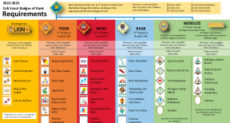 Have you, or your Scouts, ever played the game of Telephone? A group forms a circle, and the first person thinks of a message. He whispers it to the second person, and the second to the third, and so on, until it reaches the last person. The first person says his original message, and the last person repeats what he heard – usually hilariously different from the way it started. It’s a great illustration in the value of clear, accurate communication.
Have you, or your Scouts, ever played the game of Telephone? A group forms a circle, and the first person thinks of a message. He whispers it to the second person, and the second to the third, and so on, until it reaches the last person. The first person says his original message, and the last person repeats what he heard – usually hilariously different from the way it started. It’s a great illustration in the value of clear, accurate communication.
The need to get a message across clearly is important for any team to function effectively. Whether it’s a patrol, a unit committee or a Key 3 relationship, being on the same page is essential to successful group effort, and communication is the key. Failure of the message recipient to understand what they’re being told can cause the collapse of cross-functionality.
Who is responsible for clear communication? Certainly, the person delivering the message needs to be thorough and complete, but the person receiving the message has responsibility as well. This takes on two aspects: the deliverer needs to understand how to communicate with the person they’re talking to, and the recipient needs to provide feedback and ask for clarification if they don’t understand what’s being said.
Communicating with others isn’t a one-size-fits-all proposition. Everyone has a different mode that’s most effective. Some people can hear a message, understand it right away, and run with it. Others need to have things explained in as simple terms as possible. Still others need to understand the “why” of what you’re asking.
The way in which you convey a message is as important as the  message itself. In a recent article, Kristin Wong explains how seven destructive habits of communication can cause breakdowns in understanding, and how seven positive approaches and enhance it. The deadly habits she lists are all too pervasive in our society. They include fixing blame, nagging and complaining, and bribery in the quid pro quo sense. Many of us will recognize these as modes that are poisonous to effective leadership as well as communication. The positive habits – listening, accepting and trusting among them – help to further mutual understanding and improve conveying the message you intend to send.
When dealing with others, keep track of the way you say what you say, how the other person perceives what you are saying, and what the most effective way to help them get what you are saying. By paying attention not just to the message but the way the message is sent, you can hopefully avoid distorting your communication and having it be received just as you sent it.
Image: Stuart Miles / freedigitalphotos.net
This post first appeared on Bobwhite Blather.




